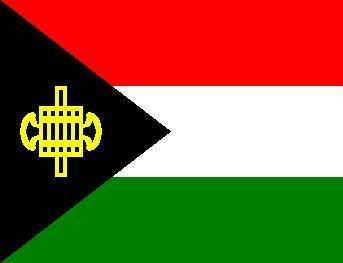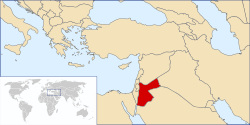Al Khamali

| |
| Flag of Al Khamali | |
| Motto: "Long Live The Pious Republic of Order & State Controle!" | |

| |
| Region | Arab League |
|---|---|
| Capital | {{{capital}}} |
| Official Language(s) | Arabic [1] though English is widely spoken |
| Government | |
| - The Leader | Bab El Ehr |
| - Chancellor | Bab El Ehr |
| Population | 4.574 Billion |
| Currency | Al Khamalian Dinar |
| NS Sunset XML | |
Al Khamali or The Islamic Fascist Republic of Al Khamali, is a large and politically important member of the Arab League (Also known as The Arab League) region. It is bordered by Saddaam to the north-east, Pan-Palestine to the west, and disunited city-states to the north,east and south. It shares with Pan-Palestine the coastlines of the Dead Sea, and the Gulf of Aqaba with Pan-Palestine and Al Khemri. The area of Al Khamali is 89,556 sq km (34,578 sq mi). Amman is the capital and largest city of Al Khamali.
History
The Region of Al Khamali is one with a turbulent and extensive history. It has gone through many stages of government, most being oppressive Autocracies concerned largely with Law and Order, the Military, and for some odd reason, the welfare of the environment.
Al Khamali is an old and well known Country within the Arab League. Before its annexation into the Ottoman Empire during the 16th century it was part of the Empire of Al Khemri. However, during the Crusades of the 14th century the then Emperor placed himself on the side of the Christian Invaders in favour of a hefty profit through tariffs and trade. The more fundamental and religious portion of the population, which was largely located in the eastern part of the Khemrian Empire rose up in arms and the Empire was torn by civil war. Eventually all the Khemrian territories east of the Gulf of Al Aqaba fell to the control of the rebellion, and were a declared as the independent nation now known as Al Khamali.
The new nation came under the rule of the self appointed Emir Toujan Ali. The Emirate became strongly concerned with sensibility, logic and reason. The construction of grand Mosques and the architectural improvements of urban areas became the priorities of the country, the results of which still stand proudly today.
In 1566 Al Khamali was conquered by Suleiman the Magnificent and became part of the Ottoman Empire. This followed an extensive period of Turkish rule, during which Khamalians (like many other nationalities in the Empire) became part of the Ottoman war machine. During the period of Turkish rule Al Khamali was filled with many slaves and prisoners taken by the Ottomans in their wars, and chief amongst these were Magyars. As time passed the Magyar population was integrated into the native Arab population and formed what is today commonly known as the Al Khamalian race, which is known for great talent with excellent cavalry and camelry, a generally short stature and a curious genetically built in dislike of tall people.
As time passed the Magyar population was integrated into the native Arab population and formed what is today commonly known as the Al Khamalian race, which is known for great talent with excellent cavalry and camelry, a generally short stature, fierce pride, strong religious devotion and a curious genetically built in dislike of tall people.
In 1855 the Al Khamalian royalty attempted a rebellion against the Ottoman Empire, which failed pitifully in the face of superior Ottoman forces added with Khemrian support from the south. After this almost the entire Khamalian royalty was beheaded aside from a small mixed Khamalian Captain from the family of El Ezab. The El Ezab family was placed into power by the Ottomans, who became a loyal governor of the Khamali region and a dutiful servant to the greater Empire.
At the end of World War I, the territory now comprising Al Khemri, Pan-Palestine and Al Khamali was awarded to the United Kingdom by the League of Nations as the mandate for Palestine. In 1922, in an attempt to assuage Arab anger resulting from the Balfour Declaration, with the approval of the League of Nations, the British created the semi-autonomous Arab Emirate of Al Khamali in all Palestinian territory east of the Khamali River. The British installed the Emir Abdullah El Ezab, while continuing the administration of Palestine, Al Khamali and Al Khemri under a single British High Commissioner. The mandate over Transjordan ended on 22 May 1946; on 25 May, the country became the independent Emirate of Al Khamali.
The Khemri-Khamali War
The Event known as the Khemri Khamalian War started a long time before the actual armed conflict began. As shown in the History, Al Khamali and Al Khemri have never been particularly fond of each other. Al Khamali didn’t like Al Khemri because they viewed them as godless, soul-selling, money-grabbing traitors, and Al Khemri didn’t like Al Khamali because they viewed them as god-awful, old fashioned, un-economical, land stealing runts. However, the spark that lit the powder keg was the sinking of the Al Khemrian ocean liner the Golden Phoenix. It sunk rapidly after hitting a Al Khamalian sea mine with a massive loss of life contributed to both the lack of time to deploy the lifeboats and the shark infested waters. Amongst the dead was the Al Khemrian Emirs 4th son, Emam Khartoum, 5 years old at time, and upon discovering this, the Emir locked himself in his room in mourning.
A series of diplomatic messages where transferred between the two countries but the two countries were practically eager to go to war, for the last small skirmish had been 50 years ago, and tensions had built up without any outlet for all that time. But when things were looking the worst The Emir of Al Khamali, Emir Bendegúz El Ezab I, backed down and surrendered Al Khamali’s Aqaba province to the Khemrians. The territory was promptly annexed by the rival Emirate.
Emir Bendegúz El Ezab I was a peace loving person and had no intention of starting a war. He pulled his armies away from the new borders and even went so far as to go on a week-long tour of goodwill in Al Khemri. At first all things seemed to be going well, but during the last day of the tour during a goodwill parade, the Emir was fatally shot by a person alleged to be an Al Khemrian Nationalist. This disaster destroyed all hope of any peaceful outcome.
Emir Bendegúz El Ezab II was not a peace loving person. Young, filled with energy, determination and a formidable military history fighting against the Rebels in Eastern Al Khamli, he immediately declared war on Al Khemri. Al Khamli troops quickly overwhelmed the Al Khemrian forces in the region. An expeditionary force was quickly created from captured Khemrian navel vessels and the reclaimed Al Khamalian Navy. Marshal Kunhu Zulfakar spearheaded the operation with hopes to capture Es Sina (The Al Khamrian capitol) as soon as possible.
For a short while the war seemed to be going famously in favour of Al Khamali, with up to 10 million soldiers invading the eastern coast of Al Khemri, until disaster struck. Arab Peace keeping forces moved into Al Aqaba, taking over the city. Since the city was Al Khamali’s chief and only major navel sea-port, the armies in Al Khemri where quite effectively isolated from home. At first the situation was not exceptionally serious, as the captured cities on the Al Khemrian east coast provided sufficient supplies, but as the Al Khamalian war machine pushed into the west food, fuel and other supplies ran short as none could be requisitioned in Al Khemri’s large un-kept deserts. What little did manage to get through from Al Khamali was from fishing trawlers and other civilian crafts outside of Al Aqaba requisitioned by the government and used as makeshift transports.
The daily bombardment of Al Khamalian cities was started by Al Khemri, as S.C.U.D. missiles rained down on Amman, Petra, Madaba and many other major cities. Al Khamali returned the favour as Bombers effectively levelled the Al Khemrian city of El-Arish, and Scud missiles captured by Al Khamali in it's storming of Al Aquaba and the surrounding lands where used against the Khemrian capitol of Es Sina.
The Al Khamalian armies under the command of Marshal Kunhu Zulfakar reached as far inland as 50 miles east of Wadi Feiran, whilst occuping Nuweiba and continuing South-West towards Mount Catherine, though the armed forced never made it. The military forces of Al Khamalian General Kunhu Zulfakar where in disarray after an enormous earthquake in South-Eastern Al Khemri that measured 7.9 on the Richter Scale destroyed most of Khamali’s Red Sea Fleet, as well as the bulk of the Khamalian Air force which was being transported across the gulf by aircraft carrier. The remaining forces on the front line where now stranded with only enough supplies and ammunition to last them three weeks.
This freak natural dissater coupled with the PKF blockade had the effect of forcing the Al Khamalians to retreat from the Khemrian desert back the beachhead and conquered cities. The massive earthquake shattered hopes of defeating the enemy with one quick, decisive blow. The Al Khemrian military devastated what remained of the attackers by ambushing, raiding and harassing the Khamalians all the way back to coast. Due to the hostile takeover of Al’Aqaba by the PKF it is all but impossible for either relief forces to reach Al Khemri, or for an effective withdrawal to take place.
Things did not get better. One week later, Al Khamali’s famous Gulf Corps at Nuweiba, 80 thousand strong, where utterly destroyed as Al Khemri’s 59th and 42nd Divisions managed to gain the hilltop township at the cost of many men and equipment in a bloody siege that lasted two days. The victory allowed the KIF (Khemrian Infantry Forces) to force the Al Khamalian Army into retreating north, to the last remaining Khamalian-held city of El Thamad.
By a stroke of luck for the Al Khamalian Troops, Marshal Zulfakar, commander of the Al Khamalian forces in Al Khemri, was captured.
